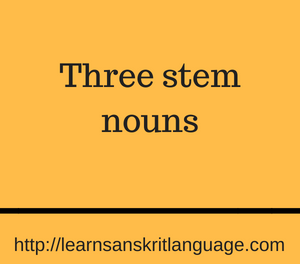The interesting thing about noun consonants is that it has a good thing and a bad thing about it. The good thing about it is that all noun consonants use same endings, whereas the bad thing is that it uses multiple stems. However, it is not fair to say that it is a bad thing, but it certainly it does make your job a bit harder.
Harder because, one stem uses a certain form, whereas, other a different one. But how do we recognize these stems? Well, it is easy to do that because they are distinguished between strong and weak vowel.
Endings Strong stem Weak stem Special stem
-at, -mat, -vat -ant, -mant, -vant -at, -mat,-vat -mān, -vān
-in, -min, -vin -in, -min, -vin -i, -mi, -vi -ī, -mī, -vī
-tṛ -tār -tṛ -tā
– at, -mat, -vat
These endings are secondary suffixes when applied to any noun, they give us the feeling of “possessing” or “having” that noun
You must be wondering, what is the difference in both of them, surprisingly; there is no difference in them. Both of them mean the same thing.
हनु –>हनुमत्
hanu –>hanumat
Fortune, glory → possessing fortune, glory,
Bhagavan, “the divine one”
हनु –>हनुमत्
hanu –>hanumat
Jaw → possessing jaws
Hanuman, who is known for a mark on his jaw.
Now let us take the noun भगवत् (bhagavat) of “mat” and “vat” and see how it behaves with other cases.
-mat and -vat (masculine)
| भगवत् | Singular | Dual | Plural |
|---|---|---|---|
| Case 1 (subject) | भगवान् bhagavān | भगवन्तौ bhagavantau | भगवन्तः bhagavantaḥ |
| Case 2 (object ) | भगवन्तम् bhagavantam | भगवन्तौ bhagavantau | भगवतः bhagavataḥ |
| Case 3 (with) | भगवता bhagavatā | भगवद्भ्याम् bhagavadbhyām | भगवद्भिः bhagavadbhiḥ |
| Case 4 (for) | भगवते bhagavate | भगवद्भ्याम् bhagavadbhyām | भगवद्भ्यः bhagavadbhyaḥ |
| Case 5 (from) | भगवतः bhagavataḥ | भगवद्भ्याम् bhagavadbhyām | भगवद्भ्यः bhagavadbhyaḥ |
| Case 6 (of) | भगवतः bhagavataḥ | भगवतोः bhagavatoḥ | भगवताम् bhagavatām |
| Case 7 (in) | भगवति bhagavati | भगवतोः bhagavatoḥ | भगवत्सु bhagavatsu |
| Case 8 (address) | भगवन् bhagavan | भगवन्तौ bhagavantau | भगवन्तः bhagavantaḥ |
Now let’s take a look at the neuter form
-mat and -vat (neuter)
| भगवत् | Singular | Dual | Plural |
|---|---|---|---|
| Case 1 (subject) | भगवान् bhagavān | भगवन्तौ bhagavantau | भगवन्तः bhagavantaḥ |
| Case 2 (object ) | भगवन्तम् bhagavantam | भगवन्तौ bhagavantau | भगवतः bhagavataḥ |
| Case 8 (address) | भगवन् bhagavan | भगवन्तौ bhagavantau | भगवन्तः bhagavantaḥ |
Did you notice one thing? The special stem that we discussed above is present only in masculine case 1 singular. To form the special stem you need to follow two steps:
• The vowel, which is present in the suffix of the strong stem is lengthened
• The last consonant present in the strong stem is removed
– in, –min, -vin
Again these suffixes are secondary suffixes. When joined with a noun, they give us the characterization of the noun. They are quite similar to the earlier suffix that we learned, bu are less complex regarding the behavior of nouns with them. However, from all of them –in is the common vowel that appears.
योग –>योगिन्
yoga –>yogin
yoga → yogin
Yoga → characterized by yoga; a yogi
हस्त –>हस्तिन्
hasta –>hastin
hasta → hastin
Hand → characterized by a hand; an elephant
in (masculine)
| योगिन् | Singular | Dual | Plural |
|---|---|---|---|
| Case 1 (subject) | योगी yogī | योगिनौ yoginau | योगिनः yoginaḥ |
| Case 2 (object ) | योगिनम् yoginam | योगिनौ yoginau | योगिनः yoginaḥ |
| Case 3 (with) | योगिना yoginā | योगिभ्याम् yogibhyām | योगिभिः yogibhiḥ |
| Case 4 (for) | योगिने yogine | योगिभ्याम् yogibhyām | योगिभ्यः yogibhyaḥ |
| Case 5 (from) | योगिनः yoginaḥ | योगिभ्याम् yogibhyām | योगिभ्यः yogibhyaḥ |
| Case 6 (of) | योगिनः yoginaḥ | योगिनोः yoginoḥ | योगिनाम् yoginām |
| Case 7 (in) | योगिनि yogini | योगिनोः yoginoḥ | योगिषु yogiṣu |
| Case 8 (address) | योगिन् yogin | योगिनौ yoginau | योगिनः yoginaḥ |
-in (neuter)
| कर्तृ | Singular | Dual | Plural |
|---|---|---|---|
| Case 1 (subject) | कर्ता kartā | कर्तारौ kartārau | कर्तारः kartāraḥ |
| Case 2 (object ) | कर्तारम् kartāram | कर्तारौ kartārau | - |
| Case 4 (for) | योगिने yogine | योगिभ्याम् yogibhyām | योगिभ्यः yogibhyaḥ |
| Case 8 (address) | कर्तर् kartar | कर्तारौ kartārau | कर्तारः kartāraḥ |
Again the special stem appears in the masculine case 1 singular to describe mat and vat nouns.
-tr
Contrary to the previous sounds, tr is a primary suffix that denotes “doer” of some action. It is quite similar to the –er endings of the English. For instance, “Maker”, “planner”,” hunter”. It is applicable in only neuter form. So let us take a look at it.
| कर्तृ | Singular | Dual | Plural |
|---|---|---|---|
| Case 1 (subject) | कर्ता kartā | कर्तारौ kartārau | कर्तारः kartāraḥ |
| Case 2 (object ) | कर्तारम् kartāram | कर्तारौ kartārau | - |
| Case 4 (for) | योगिने yogine | योगिभ्याम् yogibhyām | योगिभ्यः yogibhyaḥ |
| Case 8 (address) | कर्तर् kartar | कर्तारौ kartārau | कर्तारः kartāraḥ |
हन्तर् गच्छ → हन्तर् गच्छ
hantar gaccha → hantar gaccha
Go, O killer.
द्रष्टः पश्य
draṣṭaḥ paśya
Look, O seer.



